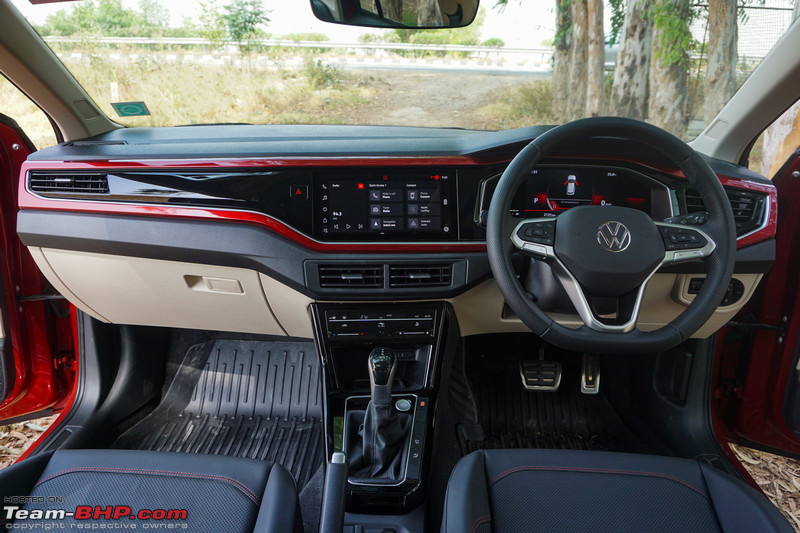| |||||||
| Search Forums |
| Advanced Search |
| Go to Page... |
 |
| Search this Thread |  2,215,178 views |
| | #1 |
| Team-BHP Support  Join Date: Apr 2016 Location: Mumbai
Posts: 1,813
Thanked: 21,564 Times
| Volkswagen Virtus Review Volkswagen Virtus ReviewVolkswagen Virtus Pros• A ‘complete’ car that just might bring some love back to sedans • Classy exterior & interior styling, along with solid build quality • Cabin has good legroom on offer, supportive seats, perfect ergonomics & enough storage • 521-liter boot is the largest in its segment (along with the Slavia’s) • 148 BHP engine makes the Virtus among the most fun-to-drive sedans in the segment • Sporty 1.0L & 1.5L turbo-petrols are mated to smooth transmissions • Sorted suspension offers a balanced ride & handling package • 5-star rating in the Global NCAP crash tests. Safety features include 6 airbags, ESC, 3-point seatbelts for all, electronic differential lock, brake disc wiping, multi-collision brake and more • Features like active cylinder tech, ventilated seats, sunroof, wireless Android Auto and CarPlay, auto headlamps & wipers etc. • 6-year extended warranty & 4-year all-inclusive service packages available Volkswagen Virtus Cons• No 1.5L diesel is a major disadvantage in a world where petrol costs over 100 bucks / litre • DQ200 DSG transmission has a history of poor reliability & breakdowns in India • Backseat better for 2 healthy adults and a child, rather than 3 adults • Lovely 1.5L TSI is only available on the top variant. Should have been there in the mid-trim too • Interior quality doesn’t feel up to oldschool VW standards. Body-coloured interior highlights are polarising too • Missing some features such as a subwoofer, driving modes (sport), 360-degree camera & electric driver's seat adjustment • Turbo-petrols are very sensitive to driving style. FE will drop drastically when you drive hard • VW’s after-sales service can be a hit or miss. The brand’s long-term reliability can be patchy as well • Slavia's 'clever' touches are missing = no spot on top of the dashboard to place a deity, no smartphone holders on the front seatbacks, no ticket clip on the windshield, no elastic band in the doorpad to keep items in place, or even something as simple as the small reflective tapes on the doors IntroductionIt's been quite a while that people have been waiting for the more sophisticated looking cousin of the Skoda Slavia. It's finally here - the Volkswagen Virtus makes its entry in the C2 segment and given the way Skoda is performing in this space, the future does look promising for this new sedan. Based on the MQB-A0-IN platform, the Virtus is an extremely important product for Volkswagen. The company's budget offering, the Vento, is really long in the tooth. In the coming days, the Virtus and Taigun crossover will be the ones responsible to draw in numbers for Volkswagen. Not just that, with the Virtus, the German company will be taking the fight directly to the segment's most successful players, the Honda City and the Hyundai Verna. It's not going to be easy, but long story short, it does seem that Volkswagen has hit the right mix to make a space for itself in this segment. The Virtus is being offered with two turbo-petrol engines - a 114 BHP, 1.0 TSI with 6-speed MT and AT transmissions and a 148 BHP, 1.5 TSI with a 7-speed DSG. Volkswagen has coined the trim lines based on the engines on offer. The 1.0 TSI is offered on 'Dynamic Line' and the 1.5 TSI is offered on 'Performance Line'. The 1.5 TSI will not be available with a 6-speed MT, which could see it lose customers to the Slavia. Additionally, there is no diesel engine on offer. Sadly, VAG has decided not to make its 1.5L TDI BS6 compliant. Those with high usage will be disappointed, especially with petrol now costing well over 100-bucks a liter! It also means that Volkswagen will miss out on a major chunk of customers that the Honda City and the Hyundai Verna are currently catering to. Volkswagen Virtus Price & BrochureThe prices of the Virtus be revealed soon. We hope that the car is priced competitively given that it is heavily localised. You can download the VW Virtus Mini Brochure.pdf. Design & StylingSkoda and Volkswagen have always catered to separate audiences when it comes to design. While the Skoda cars have an edgier look to them, the Volkswagen cars exhibit more class. The Virtus is no different. With a Jetta-esque front end and an Audi A4-like rear, the Virtus looks sleek and classy. The understated and elegant look will not only appeal to Volkswagen fans, but also to others. When it comes to dimensions, the Virtus is the longest (4,561 mm) and widest (1,752 mm) car in its segment. It also has the longest wheelbase (2,651 mm) in its segment. Notable features include LED headlamps, LED tail-lamps, a contrast black roof and 16" alloy wheels. Build Quality, Fit & FinishThe MQB-A0-IN platform on which the Virtus, Taigun, Slavia and Kushaq are based has specifically been made for the Indian market. This is essentially an affordable version of the European MQB platform and the difference is noticeable. If you compare it to some of the brand's European cars, the Virtus' doors, bonnet and boot lid don't feel as heavy. The doors make a bit of a clunky sound rather than a satisfying 'thud' on shutting. That being said, the Virtus doesn't feel flimsy. The car feels fairly well built with very little flex in the body panels. The panel gaps are tight and the overall fit and finish are as you'd expect from a European car. Wheels & TyresThe top-end variants are equipped with 16" wheels shod with 205/55 section Goodyear Assurance tyres. The Performance line gets all-black alloys and the Dynamic Line gets the diamond cut dual-tone alloys. Going by how BHPians feel about the design of the wheels, the all-black alloys haven't clicked with enthusiasts. Ground ClearanceThe Volkswagen Virtus' ground clearance hasn't been revealed yet, but we took it on some uneven patches and the car managed to get through gracefully. For reference, the Slavia has an unladen ground clearance of 179 mm. Standard & Extended WarrantyVolkswagen has its 4Ever care program in place for all its cars. It includes a standard warranty of 4 years / 1,00,000 km and 4 years of roadside assistance. You can also extend the warranty for the 5th and 6th years and we highly recommend that you invest in maximum possible extended warranty available. MaintenanceVolkswagen has been working on getting service costs under control and bringing some transparency to its operations. With a new car purchase, you get the 1 year / 15,000 km preventive maintenance service free of labour charges, where you pay only for parts and consumables. There is a service calculator on the website (click here) that will give you an approximate cost of parts and labour for the respective service intervals. While the exact prices haven't been revealed yet, the company will have a service value package for the Virtus (like the Taigun), which includes periodic maintenance services up to 60,000 km or up to 4 services, whichever is earlier. There's also a superior service value package that covers servicing costs for 5 years. SafetyThe Volkswagen Virtus is loaded with safety features such as 6 airbags, ESC, ABS, multi-collision brake, brake disc wiping, tyre pressure deflation warning, hill hold control, and ISOFIX child seat anchors. It also gets rear parking sensors, reversing camera, auto headlamps and auto wipers. The Virtus hasn't been tested by Global NCAP or the Euro NCAP yet. The Latin NCAP has crash-tested the car. However, it is the made in Brazil Virtus based on the MQB-A0 platform and not the Indianised version of it. We'd prefer to wait for the Global NCAP's report of the MQB-A0-IN based Virtus. Last edited by GTO : 3rd July 2023 at 14:10. Reason: MT now available with the 1.5L Petrol, so removing that con point |
| |  (80)
Thanks (80)
Thanks
 |
| The following 80 BHPians Thank Omkar for this useful post: | 84.monsoon, abhisheksircar, adwaith, agm, Akshay6988, AKV10, amol4184, Anumon8448, Ashutosh_kumar, audioholic, Bibendum90949, CARDEEP, CEF_Beasts, chaosengine, Chethan B G, chinmaypillay, Crazy_cars_guy, dailydriver, denny_ace, dhruvritzed, digitalnirvana, Dr.AD, espraveen, FueledbyFury, Gannu_1, GaryTSI, giri1.8, Godzilla, Goku_YNWA, GST, GTO, Harjot37, hdman, hemanth.anand, Iksvaku, InControl, JigarKansagara, kutts, KuvamBansal, LaRoca, lemedico, libranof1987, MDED, MotorDev, MoTo_meister, murthy_p, Mustang Sammy, naadopaasaka, neoakshay, NitNac, Osteon206, Pr4mod, prash1892, RaceHorse, RaghuVis, Rambo-RS, Researcher, ron178, Roy.S, Samba, sangam_mm93, SanSabh, SatishBisht, shancz, Shyam96, Siddy_1998, Simhi, SSD2122, stringbh, SuhairZain, swiftnfurious, Thad E Ginathom, theexperthand, tsi_niks1989, vaasu, vb-saan, vvrchandra, Wageabond, yogiii, ysjoy |
| |
| | #2 |
| Team-BHP Support  Join Date: Apr 2016 Location: Mumbai
Posts: 1,813
Thanked: 21,564 Times
| Cabin Design & QualityThe dual-tone black and beige dashboard is similar to what we've come to see in Volkswagen cars, but there's a modern touch to it. There is a body-coloured applique that runs across the dashboard encompassing the side air-con vents, the instrument cluster and the infotainment touchscreen. The major chunk in between is finished in glossy black and Volkswagen calls this an island-like design. This may not be to everyone's liking. We'll see what BHPians have to say about the different colours on the dashboard once the detailed brochure is out. There aren't any soft-touch plastics here, but the interiors are well put together and there aren't any rough edges in places that one would usually touch. Everything seems to be well finished in the cabin. However, the plastics don't feel premium and the cabin lacks the sturdy feel of some of the other Volkswagen cars. Space & ComfortThe dimensions of the Virtus work in its favour. It is the widest in its class and has the longest wheelbase, both of which translate to good space in the cabin. However, the Honda City does feel more spacious and airy on the inside. The leather front seats don't get lumbar adjustment, but they offer good overall support and with the right amount of cushioning, spending long hours here shouldn't be a problem. Both front seats get height adjustment and can slide back far enough even for tall occupants to feel comfortable. Apart from this, you have a soft center armrest that can slide forward as well for those needing the adjustment. The door pads too host leather-wrapped armrests which are useable. Overall, the front seats are nice to be in and most users will find the experience to be pleasant. Driving Position & ErgonomicsIn the driver's seat, you'll get acquainted with all the controls pretty quickly. The leather-wrapped steering is perfectly sized and lovely to hold, while the horn pad is easily reachable with your thumbs. The steering itself is adjustable for height and reach, which makes finding the perfect driving position that much easier. The frontal view is good even with a low seating position. The basic ergonomics of the Virtus are pretty much perfect. Everything is exactly where you would expect it to be and within easy reach of the driver. Cabin StorageThere are a good number of storage spaces in the cabin. For starters, you get a well-sized ventilated glovebox. The doorpads are pretty accommodating as well and can hold a bottle along with some other items. At the base of the center fascia is a storage compartment with a wireless smartphone charging pad. Cupholders and cubby holes have been provided in the center console as well. The center armrest has a usable deep storage area. For the rear passengers, the front seatbacks have deep pockets and the rear center armrest gets a couple of cupholders. Air-ConditioningThe Virtus comes with a "Climatronic" climate control unit with a touch control panel. Air vents have been provided at the rear as well. Even with temperatures hitting over 42 degrees in Amritsar during the media drive, the a/c functioned very well to keep us cool. A special mention of the ventilated seats that were the cherry on the top of the cake. Just like the Slavia, the Virtus also gets an 'Air Care' feature, which is essentially an inbuilt air purifier. The purifier catches fine dust particles in the cabin, prevents allergens (like pollen) from entering the cabin and absorbs any unpleasant odours. FeaturesUnique & Noteworthy FeaturesThe Virtus seems to be packed with all the necessary features that customers are looking for in a modern car these days. It has a sunroof, 10-inch touchscreen infotainment head-unit with wireless Apple CarPlay and Android Auto connectivity and an 8" virtual cockpit MID. It also gets connected car technology, wireless phone charging, ventilated seats, ambient lighting, rear air-con vents, and two USB-C charging sockets at the rear. No regular USB charging slots here though and the Virtus also misses out on a subwoofer (for that added bass) that is offered in the Slavia. Audio System & Sound QualityOn the Virtus, you get a 10" touchscreen infotainment head-unit that comes equipped with Wireless Android Auto and Apple CarPlay. The unit is snappy to use and has a sharp display and a user-friendly interface (but lacks physical buttons). The display is a fingerprint magnet and reflects everything around it - our review car had so many smudges at the end of the drive! Physical knobs for the power and volume buttons would have been nice to have. The UI is slick and there was no lag. The infotainment system gets WiFi in addition to Bluetooth and it can be used to adjust various settings such as the interior and exterior lights, mirrors, wipers, ESC (electronic stability control), instrument cluster, service settings, central locking system, valet settings etc. In terms of the sound, this is an 8-speaker system, but misses out on the subwoofer that you get in the Slavia. The sound quality is good for the segment and a non-audiophile won't find anything to complain about here. That being said, the 380W system in the Slavia feels superior with its subwoofer and amplifier. Rear Seat Comfort & SpaceGetting in and out of the rear seat isn't difficult. However, the rear bench is placed on the lower side. Hence, you will have to sit down in it rather than just slide in. Just like the front, the rear seats are comfortable and the cushioning is on point - neither too hard, nor too soft. A journey with two passengers in the rear with the center armrest in between will be comfortable. With three passengers abreast, it will be very tight for sure. While you get 3 adjustable headrests and 3-point seatbelts for all 3 passengers, it's better if the third occupant is a child and not an adult. The floor hump is wide and prominent too. There's a good amount of knee room and headroom for the adults in the rear seat. At 5'10", I didn't have any difficulty sitting behind my driving position. Only occupants well over 6' in height might find the headroom tight. If you had to compare, the Honda City and Maruti Ciaz fare better in this area, but the Virtus isn't uncomfortable at all. Overall, the space is more than adequate for most passengers. The backrest is also set at a comfortable angle. However, I would have liked more under-thigh support here. Rear occupants get a/c vents and a couple of USB-C ports for charging their smartphones. Boot SpaceAt 521 liters, the Virtus and the Slavia have the largest boots in the segment. The rear seat is split in a 60:40 ratio. Folding the backrests down gives the car a lot more luggage capacity. Last edited by Aditya : 6th May 2022 at 10:01. |
| |  (56)
Thanks (56)
Thanks
 |
| The following 56 BHPians Thank Omkar for this useful post: | abhisheksircar, agm, Akshay6988, Anumon8448, Bibendum90949, blackwasp, CARDEEP, CEF_Beasts, chaosengine, Chethan B G, chinmaypillay, dailydriver, dean5545, denny_ace, digitalnirvana, Dr.AD, espraveen, fluidicjoy, GaryTSI, giri1.8, Goku_YNWA, GTO, hemanth.anand, Herschey, Iksvaku, InControl, JigarKansagara, libranof1987, MDED, naadopaasaka, NitNac, PM - B, Pr4mod, prash1892, PrasunBannerjee, RaghuVis, Rajeevraj, Rambo-RS, Researcher, Roy.S, Samba, SatishBisht, Shyam96, Siddy_1998, Simhi, SSD2122, stringbh, suryatks, swiftnfurious, theexperthand, vaasu, vb-saan, vredesbyrd, vvrchandra, yogiii, ysjoy |
| | #3 |
| Team-BHP Support  Join Date: Apr 2016 Location: Mumbai
Posts: 1,813
Thanked: 21,564 Times
| Driving the Volkswagen Virtus 1.5L DSG Automatic1.5L, 4 cylinder turbo-petrol engine makes 148 BHP @ 5,000 - 6,000 rpm and 250 Nm @ 1,600 - 3,500 rpm:  The 1.5L engine in the Virtus is shared with the Slavia, Taigun and Kushaq and we were mighty impressed when we drove it previously. This engine gets 4-stroke positive ignition direct injection with active cylinder technology. It's offered only with a 7-speed DSG AT (Slavia gets a 6-speed MT too). On paper, the engine produces 148 BHP & 250 Nm which is much more than Honda City 1.5's 119 BHP and Hyundai Verna 1.0's 118 BHP. These figures put it in a different league altogether. Fast and effortless at any legal speed, this powertrain compliments the ride and handling characteristics of the car beautifully. The combo makes the Virtus an effortless mile-muncher if fuel prices aren’t a concern  . .Slot into D mode, take your foot off the brake pedal and the Virtus DSG slowly creeps forward. This will be highly appreciated in heavy traffic conditions where you can drive with just the brake pedal. With a light foot, the gearbox moves up the ratios pretty quickly. Impressively, you won't feel these shifts as the transition is butter smooth. While the automatic transmission makes the Virtus very easy to drive in the city, when crawling in slow traffic (1st - 3rd gears), you will experience a little jerkiness, which is a typical DSG trait. In the city, the 1.5 motor's healthy bottom end helps you get around effortlessly. The throttle response is good and the Virtus rolls smoothly. Add to that, the direct-injection and turbocharger ensure that the engine isn't lethargic at any speed. There's always enough power on tap to accelerate or overtake quickly. Out on the highway is when things go from good to great! This is easily among the most fun-to-drive sedans for 2 million bucks. You'll find yourself addicted to flooring the throttle whenever there's an empty stretch of road. Volkswagen claims a 0-100 km/h time of 9 seconds for the 1.5 TSI DSG. Outright performance is excellent and the strong mid-range takes care of all the overtaking you need to do. Downshifts are quick (not as fast as upshifts though) and the gearbox responds well to throttle inputs. The 7th ratio gives the Virtus DSG long legs on the highway. And touring you must do - this car is built for long road trips. In terms of cruisability, the 1.5 TSI can run at triple-digit speeds all day long without breaking into a sweat. The engine spins at a relaxed ~1,900 rpm at 100 km/h. In summary, the 1.5 TSI DSG is a jewel of a combination that will keep you happy at low revs & high, and in the city as well as on the highway. Other than its reliability woes, this is one of the best AT gearboxes sold in India. IMO the 1.5L TSI sounds great even at high revs. It has a very sporty tone to it which is addictive too. If you are continuously driving hard and / or in ‘S” mode, your passengers might complain about the sound though. Tap the left paddle for a downshift and manual mode is engaged. The ECU blips the throttle to match the revs and holds the gear till near the redline. This gets addictive, especially during overtakes! However, even in manual mode, the DSG will upshift above ~6,250 rpm and also downshift below ~1,000 rpm. We feel this is on the conservative side. Manual mode will also ignore wrong gear selections which put the engine out of the above rpm ranges. Long hold the paddles to revert to auto mode. Cruising around in D mode, one won't even notice the gears being shifted. They are damn smooth. The kickdown response time is quick enough and you will never feel that the gearbox is hunting for gears either. It's in the right ratio almost all the time. When you are in the mood to drive the car aggressively, engage Sport mode by pushing the gear lever down once. In S, the gearbox downshifts to keep the car in the powerband, holds the ratios longer and lets the punchy mid-range do all the heavy lifting required. Out on the open road, you will find it hard to resist the urge to go hard on the throttle. The Virtus is simply brilliant to drive! On the flip side, we have scarily serious concerns over the DSG's long-term reliability. Just search on Team-BHP and you will see story after story of DQ200 failures & breakdowns. This gearbox has inherent design defects IMHO. Some BHPians who can't resist the DSG have mentally committed themselves to 2 breakdowns over 8 - 10 years of ownership. If reliability is your topmost criteria, you should pick the 1.0 with a torque-converter AT, or consider another car model altogether. Noise, Vibration & Harshness (NVH)The 1.5L TSI is overall refined. It's a lot smoother than the 1.0 TSI, which has some 3-cylinder vibrations. All the vibrations are well controlled and so is the engine noise inside the cabin. At high revs, the engine note sounds sporty. Mileage & Fuel EconomyThe 1.5L engine comes with Active Cylinder Technology. When cruising calmly on the open road, the ECU shuts off cylinders 2 and 3 to reduce fuel consumption. This 2-cylinder mode will lead to good long-distance FE, that is if you drive calmly (which is tough in the TSI). The Virtus' ARAI fuel efficiency numbers haven't been revealed yet. Driving the Volkswagen Virtus 1.0L Turbo Petrol AT1.0L turbo-petrol engine makes 114 BHP @ 5,000-5,500 rpm and 178 Nm @ 1,750-4,500 rpm: 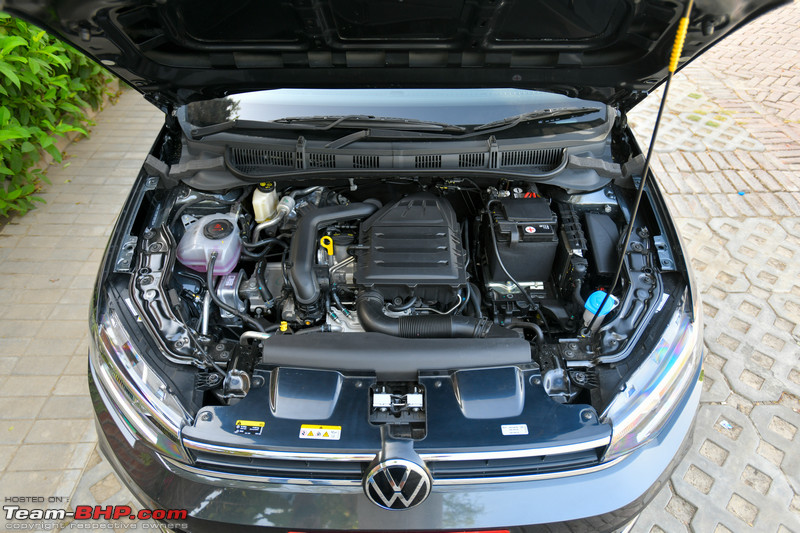 The other engine option in the Virtus is a 999cc, turbocharged, 3-cylinder, direct-injection petrol engine that puts out 114 BHP and 178 Nm. This engine is paired with either a 6-speed manual (MQ200-6F) gearbox or a 6-speed torque converter automatic (AQ250-6F) and we got to test the latter. In comparison, the Honda City's 1.5L naturally-aspirated, 4-cylinder petrol engine makes 119 BHP and the Hyundai Verna's 1.0L, 3-cylinder turbo-petrol engine makes 118 BHP. The Verna's 1.5L, naturally aspirated, 4-cylinder engine produces 114 BHP. The Virtus' 1.0 TSI is the same engine that we saw in the Vento 1.0 TSI, however in a different state of tune. Right off the bat, the key difference is that in the Virtus, it makes more power, but is tuned more towards comfort. When it comes to driving, the throttle response is satisfactory and the Virtus moves off the line with ease. The engine is tractable and isn't dead at low rpms. But, there is little turbo lag. If you really want, you can pull from under 1,000 rpm, but it's only when you cross 1,500 rpm that the motor starts feeling more comfortable. The turbo kicks in at ~2,000 rpm and if you're used to a strong turbo kick, you will be slightly disappointed by the soft power delivery of this unit. Overall, the city driveability is good and the power delivery is nice and linear. Combined with a light electric power steering, good ergonomics and excellent all-round visibility, the Virtus is very city-friendly. Out on the highway is where you will appreciate the mid-range and the top-end of the engine. Past the 2,000 rpm mark, the engine pulls nice and clean all the way till 5,500. If you're pushing hard, this is where you would want to be. A bonus here is that the engine doesn't sound coarse at high revs, in fact, it sounds quite sporty. Even beyond 5,500 rpm, the top-end isn't flat and the engine keeps pulling all the way till 6,600 rpm. Highway cruising is a comfortable affair too in the Virtus and it can do triple-digit speeds quite easily. All in all, while this engine may not be lightning quick, it is definitely fast and smooth. The 6-speed torque converter is butter-smooth in its operation and you will barely notice the shifts happening. Also in day to day driving conditions, the torque converter automatic makes sure you are in the right gear almost all the time. We didn't find it getting confused or hunting for gears at any point and the AT will keep most drivers happy. You do get a manual mode and there are paddle shifters if you want full control, but like most torque converters, these aren't very engaging. Most owners will just let the electronics do all the shifting. One of the biggest advantages, however, is that given the conventional design of a torque converter, this would prove to be more reliable in the long run compared to the DSG automatic in the 1.5L turbo-petrol. Noise, Vibration & Harshness (NVH)The 1.0L TSI is overall a refined motor. Despite being a 3-cylinder engine, the vibrations and noise are well controlled. On the move, things are fine at regular rpms. It's only when you hit high revs that the 3-cylinder thrum is obvious. But it’s an enjoyable, sporty note. Road and tyre noise are also kept in check. On the other hand, wind noise did start creep in at 90 km/h, but it was not excessive. Mileage & Fuel EconomyIf driven with a light foot, the 1.0 TSI AT should give you acceptable FE. However, do keep in mind that turbo-petrol cars are sensitive to throttle input and the torque converter automatic does seep in more fuel than a manual. So, drive the car hard and you'll see the tank needle drop very fast. To aid the fuel efficiency, you get an idle start/stop system that shuts off the engine when the car is stationary and the gear position is neutral. Ride ComfortThe Virtus comes with a McPherson strut suspension at the front and a twist-beam rear axle. It rides on 16" rims shod with 205/55 R16 tyres. The recommended tyre pressure is 33 PSI all around with two people on board. Under most driving conditions, the Virtus' ride quality is compliant. In comparison with the Slavia, there's a hint of stiffness on the Virtus, but the difference isn't stark like it was in Octavia and Jetta. At low speeds going over some rough roads, you will appreciate the absorbent nature of the suspension as it keeps you comfy. Body movement is controlled well and the suspension soaks up small potholes with ease. Big potholes do register themselves sharply in the cabin though. Handling & DynamicsThe Virtus' road manners are pretty sorted. The straight-line stability is great and the car feels extremely steady cruising at speeds of 100-120 km/h. Long road trips should be pretty comfortable in this sedan. Get to some twisty roads and the Virtus won't disappoint. The light front end makes it easy to attack corners. There is a bit of body roll, but it is well controlled and doesn't feel excessive even when pushing the car hard. This allows you to carry more speed into corners. There's a hint of understeer, but the Virtus manages to hold its line nicely. Our test car was equipped with Goodyear Assurance Triplemax 2 tyres and they worked fine for the power on offer. The 1.5L TSI does feel a bit stiffer than the 1.0L TSI as the suspension has been tuned to better suit the extra weight in the front. The ride, though not plush, is still compliant. Even over bad roads, it doesn't feel uncomfortable. As the speed increases, the ride gets better. The slightly stiffer suspension setup of the 1.5 TSI makes it even more capable in the corners than the 1.0 TSI. SteeringThe EPS is light at parking & city speeds which is now the market's preference. For daily driving, this steering works just fine. It weighs up nicely as the speed increases, but libranof1987 wished it would've weighed up even more at high speeds. What deters the driving experience is that there's no feedback from the steering and it feels very disconnected. For a car that has good power and also a chassis to complement that power, the steering just feels like the oddball here. BrakingIn this segment, only the Hyundai Verna top-end 1.0 turbo petrol gets all-wheel disc brakes. The Virtus gets discs at the front and drums at the rear. The brake pedal is well calibrated and feels sharp to use. The braking is powerful and very confidence-inspiring. Niggles & ProblemsVW is generally known for expensive maintenance bills and the occasional major breakdown. Truth is, many owners have suffered multiple breakdowns, especially with the DQ200 DSG gearbox. Even apart from the gearbox, don't expect a Toyota or Maruti kind of ownership experience over 5 - 10 years. Take the extended warranty without a second thought, and be sure to get the car serviced on time. For its part, VW is trying to improve its brand image with the Sarvottam 2.0 initiative, and there are maintenance packages too, but the dealers are the same, the cars are complicated & the parts are expensive. Those buying the 1.0L AT (torque converter) / MT might enjoy better long-term reliability than owners of the 1.5L DSG. No insulation sheet under the bonnet:  Last edited by Aditya : 6th May 2022 at 18:40. |
| |  (56)
Thanks (56)
Thanks
 |
| The following 56 BHPians Thank Omkar for this useful post: | abhisheksircar, agm, Akshay6988, Anumon8448, CARDEEP, CEF_Beasts, chaosengine, Chethan B G, chinmaypillay, dailydriver, digitalnirvana, dkaile, Dr.AD, espraveen, GaryTSI, giri1.8, Goku_YNWA, GTO, Harjot37, hemanth.anand, Iksvaku, InControl, JigarKansagara, klgiridhar, libranof1987, MDED, Mustang Sammy, naadopaasaka, NarediAni7518, NitNac, Pr4mod, PrasunBannerjee, Rambo-RS, Researcher, rideon74, rkv_2401, romeomidhun, ron178, Roy.S, saket77, Samba, SanSabh, Siddy_1998, Simhi, SSD2122, stringbh, swiftnfurious, Thad E Ginathom, theexperthand, Turbanator, vaasu, vb-saan, VinNam, vvrchandra, yogiii, ysjoy |
| | #4 |
| Team-BHP Support  Join Date: Apr 2016 Location: Mumbai
Posts: 1,813
Thanked: 21,564 Times
| Volkswagen Virtus Exterior ImagesThe traditional Volkswagen face. It bears resemblance to the erstwhile Jetta with its clean and understated look:  The clean design continues at the rear as well. Usage of chrome at the bottom of this Performance line might not be to everyone's liking. I'm not a fan of the scattered lettering of car names, but this 'Virtus' badging on the trunk doesn't look bad in flesh:  The side profile is sleek with the roof sloping down giving a coupe-like appearance. All elements are proportionately sized: 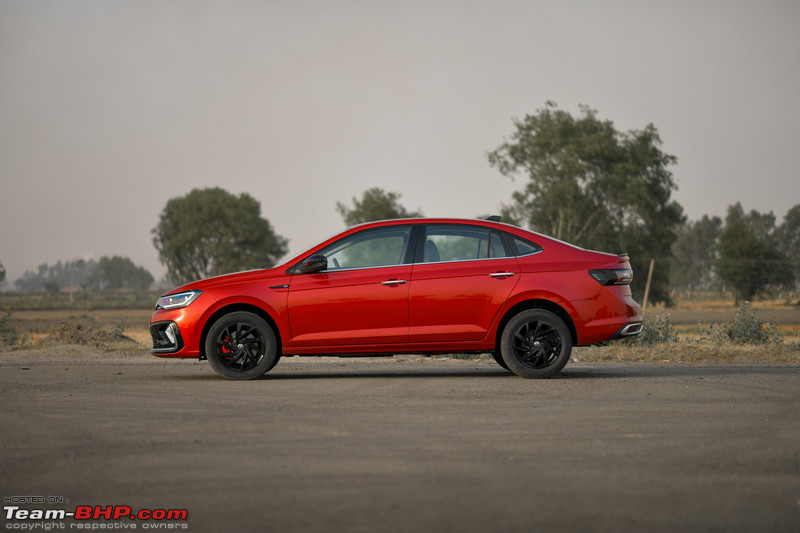 The Virtus looks very good in person, especially from this angle. It has a good stance and distinct lines across its body, which give it a muscular look. A lot of Volkswagen fans will prefer this understated yet clean look over the Slavia: 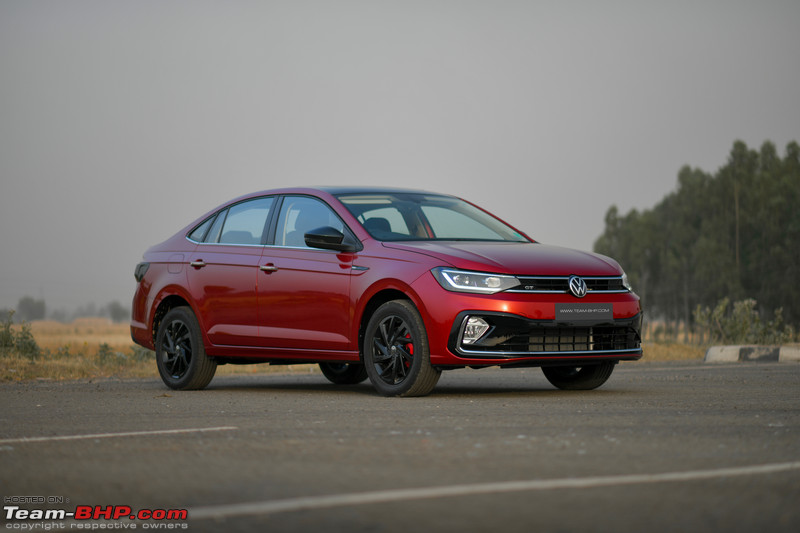 The Virtus measures 4,561 mm in length, 1,752 mm in width (excluding mirrors) and 1,507 mm in height with a wheelbase of 2,651 mm:  Neat looking LED headlamp clusters feel as if they're an extension of the grille. The dual pod setup has turn-indicators on the inside and an LED module for low beam and high beam on the outside. The outlining LED DRL looks good: 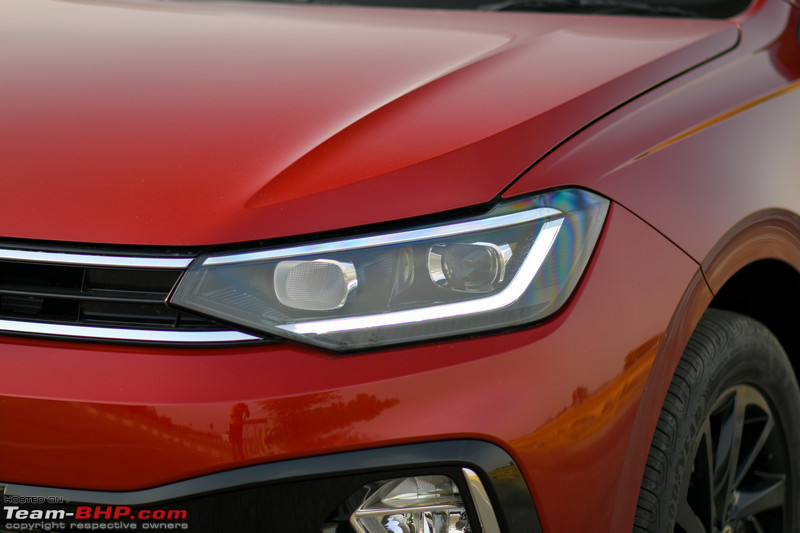 Chrome on this particular Performance line radiator grille looks out of place. GT badging on the side is placed perfectly to distinguish it from other variants: 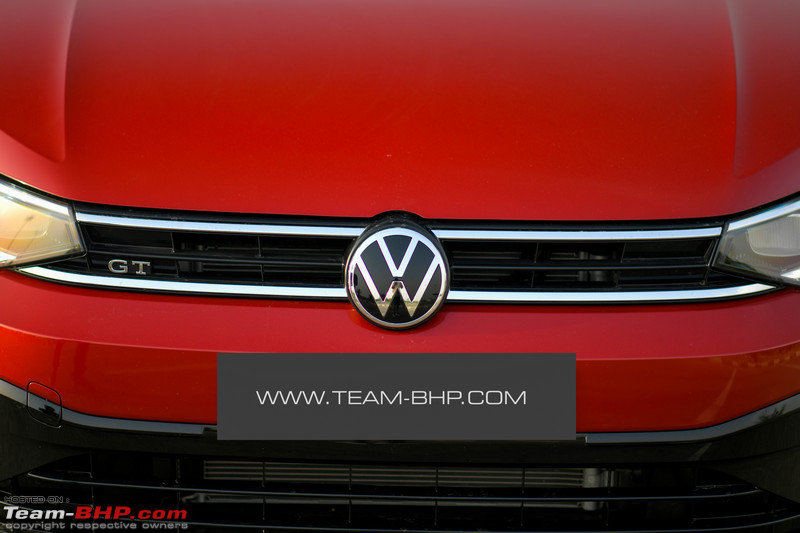 The front bumper features a wide air dam surrounded by a glossy black applique. The bottom and side portions get a chrome outline that also borders the fog lamps on either side:  Halogen fog lamps sit on the bumper just below the headlights. They double up as cornering lamps:  Plastic underbody protection at the front does not stretch back a long way. The ground clearance is good enough, but given our road conditions, full underbody protection would've been appreciated:  Prominent creases on the bonnet add to the muscular look of the car:  Just look at the number of creases on the body! Also, note how tight and even the panel gaps are:  Front fenders house classy looking piano black inserts with chrome "GT" lettering:  The Performance Line Virtus with the black roof had black ORVMs with integrated turn indicators. Body-coloured ORVMs are offered with single-tone body colour options:  Chrome inserts have been provided on all door handles. Both front doors get request sensors:  'Volkswagen' embossing on the B-pillar looks classy: 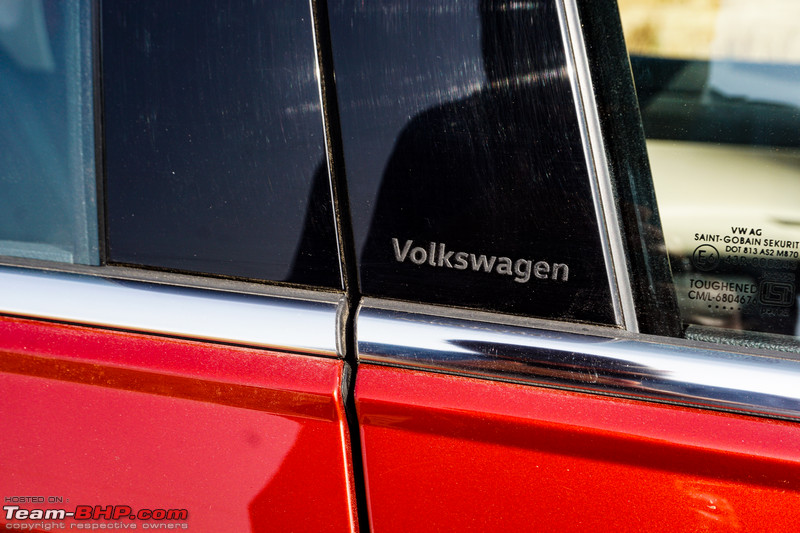 The glass area is adequate for the size of the car. Window line with chrome insert rises to form a nice kink close to the C-pillar:  16" all-black alloy wheels shod with 205/55 section tyres frankly look too bland for the Performance line. The red brake callipers however look excellent with this Wild Cherry Red body colour:  The Dynamic line gets nice looking diamond cut dual-tone alloy wheels:  Even the Dynamic line 1.5L TSI does not get rear disc brakes. Still, braking performance is strong:  "VW" branded tyre valve caps are a nice touch:  Just like the other cars in the segment, the Virtus does not get a panoramic sunroof. Instead, you get a regular unit, which is adequately sized. The black roof on this Performance line looks excellent with the Wild Cherry Red colour:  A black sharkfin antenna sits at the end of the roof section:  Split tail-lamp clusters feature a sharp looking arrow-like LED element. It also includes halogen units for the turn-indicators and reversing lights:  Performance line's boot lid gets a contrast black lip spoiler: 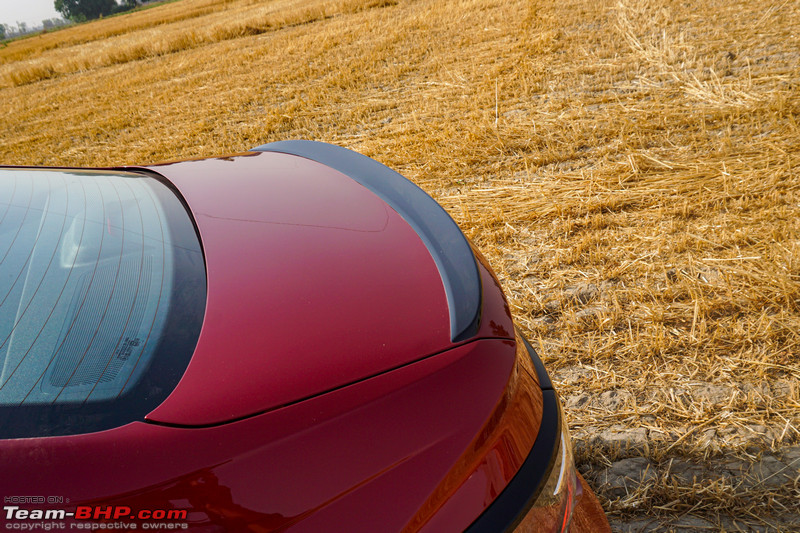 The rear bumper has a black portion at the bottom that houses reflectors on either side along with chrome detailing. 3 parking sensors have been provided:  'GT' badging for the Performance line on the boot. The Dynamic line gets a 'TSI' badge here:  A twin exhaust pipes on the left in the 1.5 TSI. The 1.0 TSI gets a single exhaust: 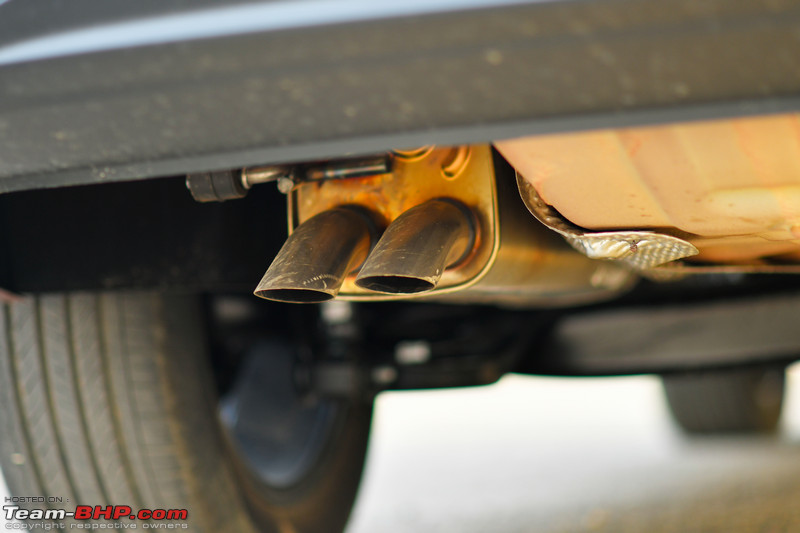 There are 6 body colour options to choose from. Here, the car is seen in Carbon Steel Grey and Wild Cherry Red. Other colours include - Candy White, Curcuma Yellow, Reflex Silver and Rising Blue Metallic: 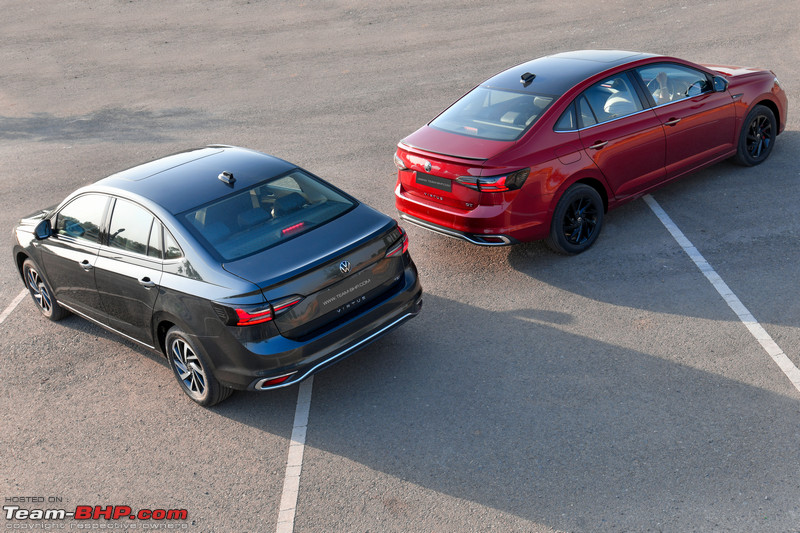 Last edited by Aditya : 6th May 2022 at 10:02. |
| |  (68)
Thanks (68)
Thanks
 |
| The following 68 BHPians Thank Omkar for this useful post: | abhisheksircar, AbidIqbalShaik, agm, Akshay6988, Anumon8448, AYP, blackwasp, CARDEEP, CEF_Beasts, chinmaypillay, dailydriver, dean5545, denny_ace, digitalnirvana, dkaile, doxinboy, Dr.AD, espraveen, GaryTSI, giri1.8, Goku_YNWA, graaja, GTO, Harjot37, hemanth.anand, iampulo, InControl, JigarKansagara, klgiridhar, libranof1987, MDED, MoTo_meister, naadopaasaka, NarediAni7518, Nazaar25, NitNac, Osteon206, pavi, PearlJam, Peri_patetic99, PGNarain, Pr4mod, PrasunBannerjee, RaceHorse, RaghuVis, Rajeevraj, Researcher, rkv_2401, ron178, Roy.S, sachin_cs, Samba, SanSabh, SatishBisht, Sayan, Simhi, SSD2122, stringbh, theexperthand, Turbanator, vaasu, vb-saan, Venkygupta, VinNam, vipinS, vvrchandra, yesyeswe, yogiii |
| | #5 |
| Team-BHP Support  Join Date: Apr 2016 Location: Mumbai
Posts: 1,813
Thanked: 21,564 Times
| Volkswagen Virtus Interior ImagesDashboard design is modern and looks contemporary. There are no soft-touch plastics here, but it is nicely finished. This is the interior of the 1.5 TSI Performance line car finished in Wild Cherry Red:  Dynamic line gets silver accents on the dashboard instead of the red seen in the Performance line:  Leather-wrapped steering wheel looks nice and feels good to hold. It has tilt & telescopic adjustments, which is of great convenience. Nice sounding dual disc horns, but not the classic Volkswagen wind tone unit that you get in the Tiguan:  LHS buttons are for the cruise control system and audio volume, while the ones on the RHS are for the virtual cockpit and to the change tracks: 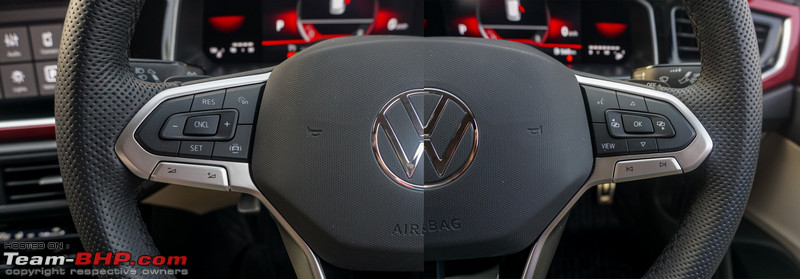 Left stalk houses light / indicator controls and on the right, is the wiper stalk. The Virtus is equipped with auto wipers which are on by default: 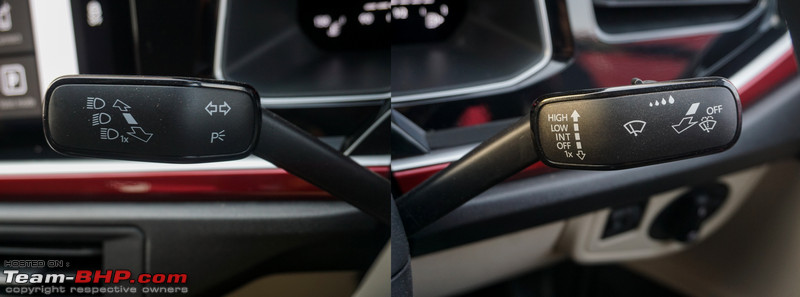 Both automatic variants - 1.0 TSI AT and the 1.5 TSI DSG get paddle shifters. These are made of plastic and feel sturdy:  Unlike in the Slavia, the engine start button is located just ahead of the gear shifter: 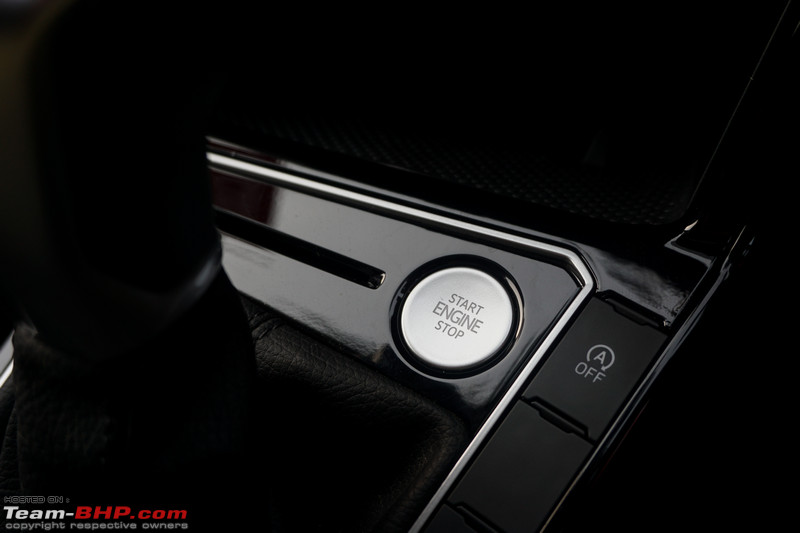 8" digital cockpit is shared with the Slavia and displays plenty of information. The instrument cluster gets digital temperature and fuel gauges and shows the time, outside temperature and distance-to-empty. Notice the chrome display around the display:  The digital cockpit gets multiple display options that can be selected by using the buttons on the steering. You can select what information you want to be displayed primarily like the speedometer or the tachometer or you can even have a minimalist display of just the speed in km/h. You can also choose to have the driving statistics displayed in between the tachometer/speedometer. The MID also displays a notification when traction control is switched off and you also get the trip information when you switch off the car:  Side AC vents have glossy black surrounds and then, a body coloured applique - red in case of this Performance line: 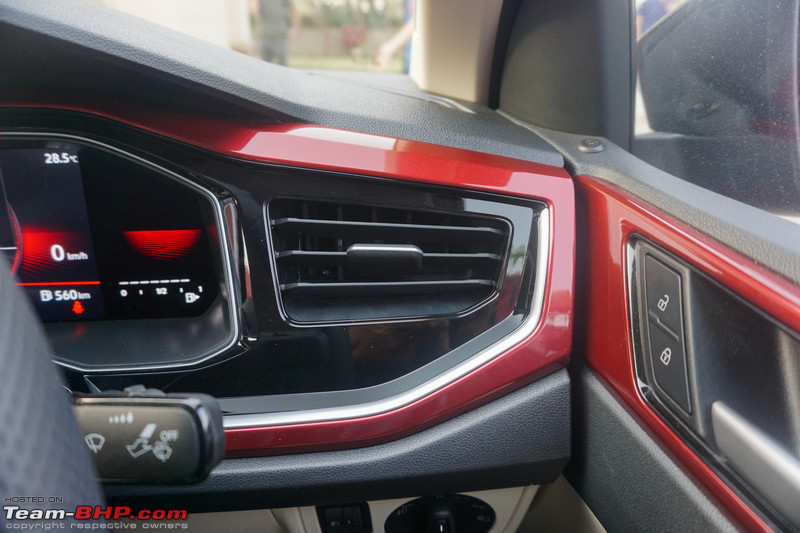 Typical European headlamp and fog lamp controls. The Virtus gets automatic headlamps. The all-black knob here looks too rudimentary & boring. It could have done with a silver metal highlight:  Dual-tone theme continues on the doorpads as well. All four doors are missing the reflective tape at the bottom like we have seen in the Slavia (reference image):  Brushed silver door handle gets central locking buttons next to it. It is surrounded by the body-coloured plastic applique like on the dashboard:  Usual set of window and mirror controls. Driver's window gets auto up & down with an anti-pinch function. Just like in the Slavia, we found this plastic panel to be low rent:  Door pockets can hold a water bottle and some other stuff. There's a recess on the inside to carry long items too. The Slavia's string to keep standing items in place is missing here:  Leather seats are broad and comfortable. The driver seat misses out on lumbar adjustment, but back support is fine. The seat offers a good adjustment range (fore & aft and height) and even a 6-footer will be comfortable: 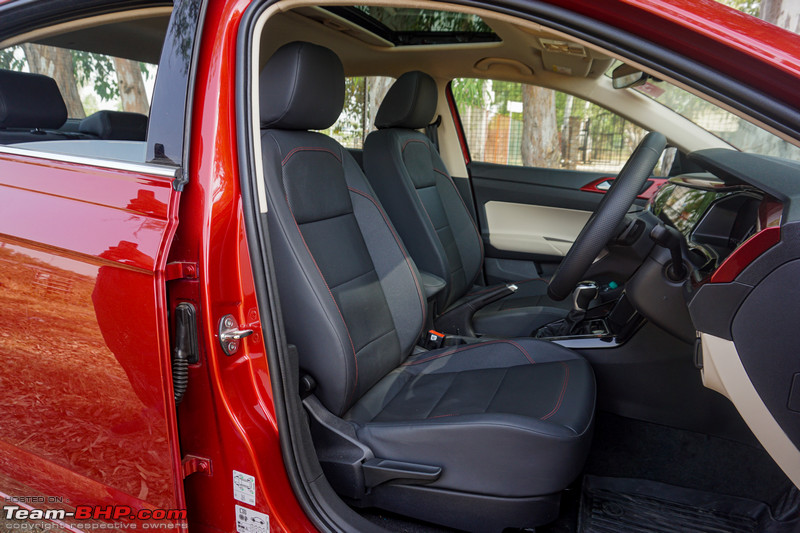 A close look at the all-black perforated leather seat upholstery with contrast red stitching on the Performance line 1.5 TSI. Perforated material is mandatory for the seat's cooling function. The quality of materials used is good: 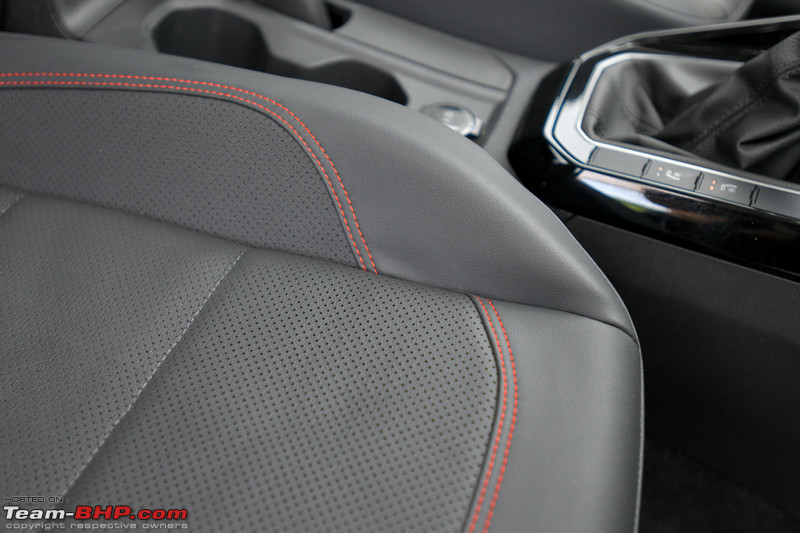 Dynamic line 1.0 TSI gets dual-tone black and beige upholstery with white stitching:  Even the passenger seat gets height adjustment! 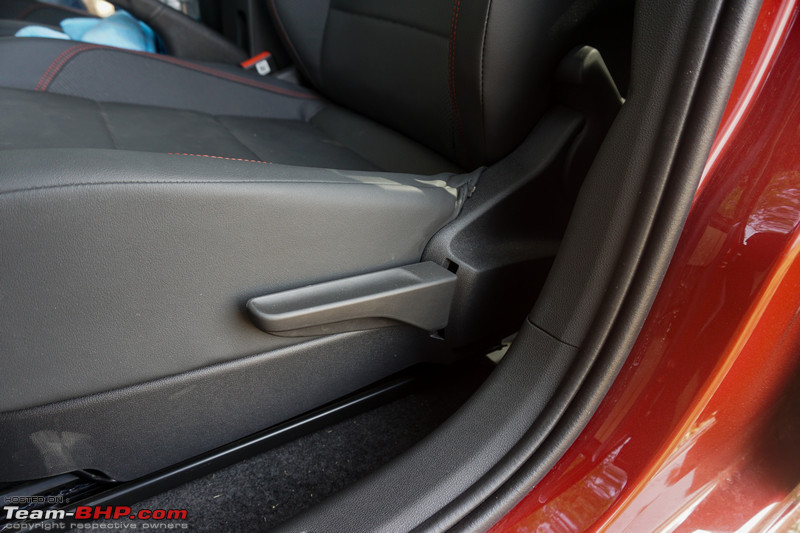 Center armrest has a soft leather cladding with white stitching. It is adjustable and placed at a comfortable height: 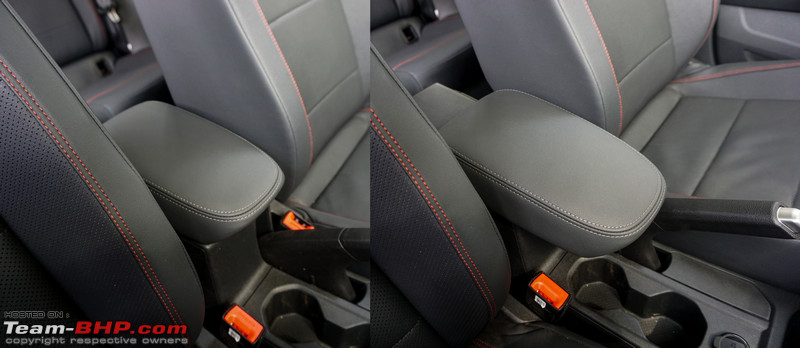 Seatbelts aren't adjustable for height. Still, their position is neutral and no one will have an issue:  Here's a look at the sporty aluminium pedals of the Performance line trim. The dead pedal is set at a comfortable angle. However, I wish it was a little wider at the top:  Dynamic line gets rubber pedals:  We feel that Volkswagen has gone for form over function with the ORVMs. We would have liked them to be a size bigger in terms of width. They should have extended out more and you will find yourself craning your neck when joining the main road. Notice how the driver can see the blinker from the inside (like in many other VAG cars):  IRVM gets a slim frame and an auto-dimming function. It is wide enough to cover the rear windshield. Headrests (including the one for the 5th occupant) do restrict visibility to some extent: 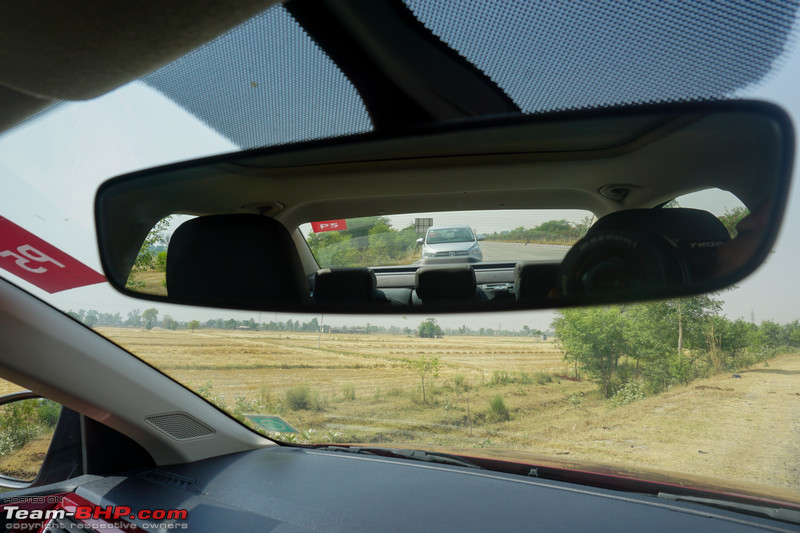 The center fascia is visibly tilted towards the driver and hosts a 10" floating touchscreen at the top:  A look at the home screen of the tablet-like floating touchscreen head unit. I liked the display and it is smooth to use. Wireless Android Auto and Apple CarPlay have been provided. The 8-speaker sound system will keep most owners happy: 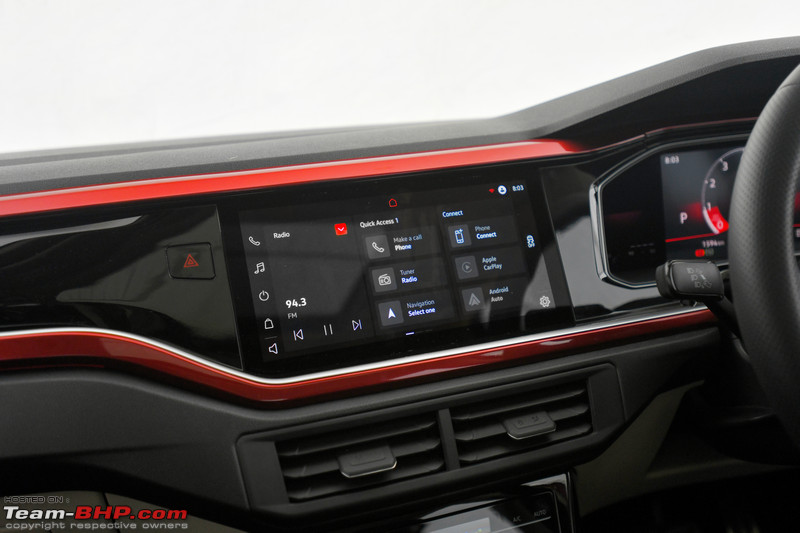 The system displays the usual driving data. Vehicle status (including low tyre pressure warnings) are also shown. 'Valet Mode' lets you hand over the vehicle to a driver with restricted access. Wireless Apple CarPlay and Android Auto work well: 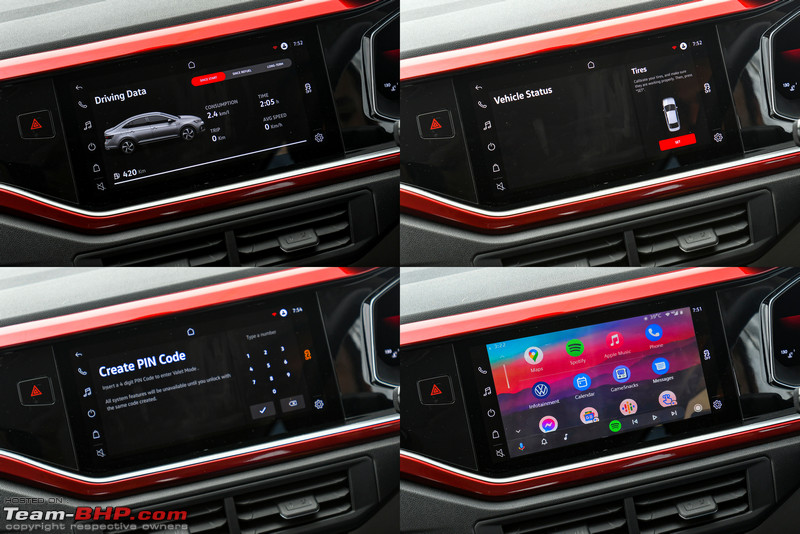 Reversing camera doesn't have adaptive guidelines:  A closer look at the central air-con vents. They feel sturdy, but adjusting them does take some added effort:  The climate control panel is touch-sensitive. We would've preferred physical buttons here as you need to take your eyes off the road to toggle through the functions:  Just below the air-con controls, is a wireless charging pad. Notice that the Virtus is equipped with Type-C USB ports. There's not one regular USB port in the car. I feel that adding Type-C USB ports is not a good idea as most people still use regular USB cables today:  Automatic gear shifter looks classy with a glossy black finish on the top. Both the automatics (1.5 TSI DSG and 1.0 TSI AT) get the same gear lever. Buttons for the idling start / stop system and ventilated seats are placed next to the gear shifter:  Two cupholders with a rubber base. The Slavia gets a non-slip base and a different design (reference image). 12V power socket is located just ahead: 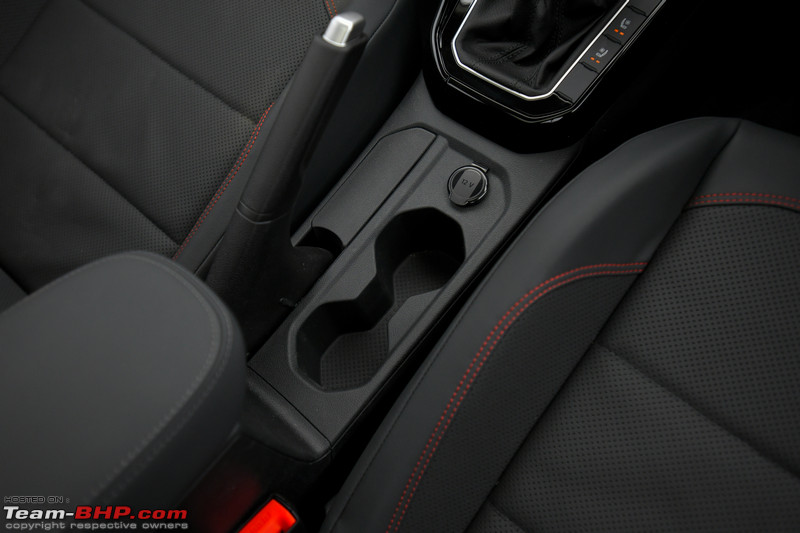 Beneath the center armrest is a storage compartment: 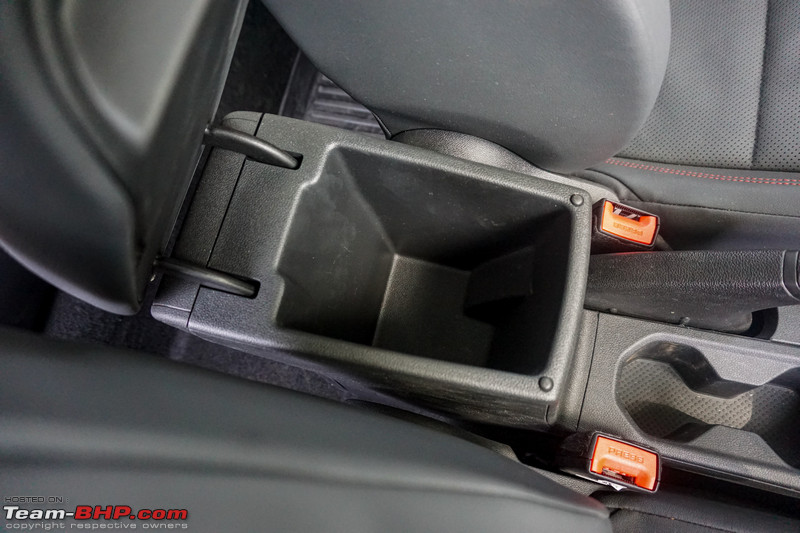 A close look at the detailing on the dashboard. The body-coloured applique on the performance line will polarise opinions. Piano black is used in between to create an 'island-like' look:  Below the body-coloured applique, there is the ambient light strip:  Medium-sized glovebox is ventilated but not illuminated. It has a cardholder and four coin holders too:  Roof bezel holds two individual map lights, the sunroof controls and the Bluetooth mic:  While the roof liner is of better quality than in the Taigun, it still doesn't feel premium. It flexes easily which makes it feel budget-grade: 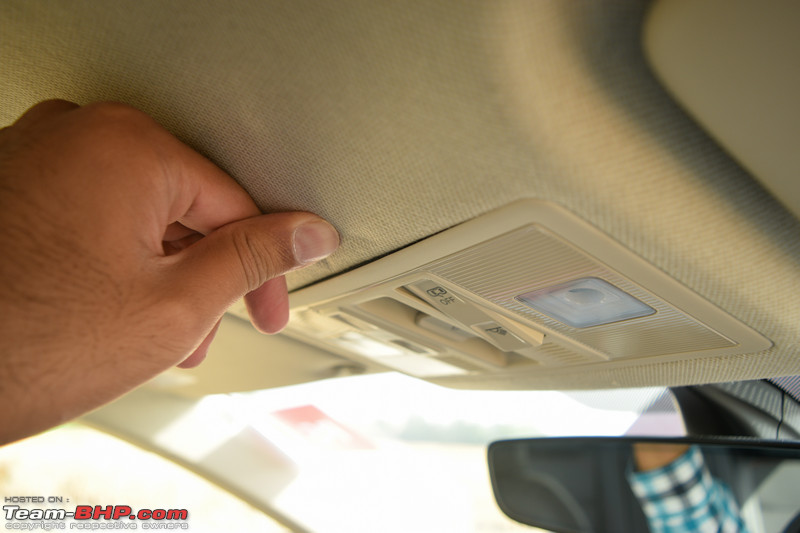 A total of 6 airbags, including dual front airbags, side airbags (no seat covers please) and curtain airbags:  The sunroof does a good job of keeping the cabin bright and airy:  Rear doorpads have an identical theme to the front ones. The front and rear doors, both, open in a triple-stage action:  Legroom is healthy and even two 6-footers can sit one behind the other comfortably. The floor hump is wide and prominent. This coupled with the rear air-con means that the middle passenger will prefer to put his feet on either side of the hump:  A look at the maximum and minimum legroom for rear passengers:  At 5'10" I was pretty comfortable sitting behind my driving position. There's enough headroom and legroom here, but the under-thigh support could've been a little better. The backrest is set at a comfortable angle and the armrest is at a comfortable height too:  Center armrest is wide and soft and also has two cupholders:  Rear seat has nice contours for support. While three 3-point seatbelts and three adjustable headrests have been provided, the rear seat is better suited for 2 adults and a kid (rather than 3 healthy adults). If it is two overweight adults, even a kid cannot be accommodated. Also, the middle area of the backrest protrudes (due to the armrest) and the seat base is elevated in the center. The headrests have a firm compound:  Top tether for the child seat (there are two of them):  Both front seats have deep seatback pockets, but you will miss the Slavia's smartphone pockets here:  Two Type-C USB charging ports are provided below the simple rear vents. Wish Volkswagen had provided at least one Type-A port which is more widely used today:  Rear cabin lamp is located right above the rear seats. It has two individual LED lights:  At 521 liters, the Virtus (along with the Slavia) has the biggest boot space in the segment. The loading lip is low and the mouth is wide:  The rear seats can fold down in 60:40 ratio for added boot space:  Spare is a 16" rim with a 205/55 section tyre. Tools are housed in a Styrofoam casing inside the spare wheel. The Slavia gets a subwoofer here (reference image):  A single boot lamp is placed at the top. The exposed metal is quite an eyesore. The area near where the gooseneck hinges for the boot retract is very much exposed. You can even see the seatbelt mechanism for the rear seats from here. Volkswagen should've figured out a way to cover this up:  Boot lid gets partial cladding on the inside:  Disclaimer: Volkswagen invited Team-BHP for the Virtus test-drive. They covered all the travel expenses for this driving event. Also, credit for some of the pictures goes to Volkswagen & their team of photographers! Last edited by Aditya : 6th May 2022 at 12:22. |
| |  (107)
Thanks (107)
Thanks
 |
| The following 107 BHPians Thank Omkar for this useful post: | 5hank3r, abhisheksircar, adwaith, agm, Akshay6988, arjunsatheesh, Arnav612, AYP, blackwasp, BopsKA12, CARDEEP, catchjyoti, CEF_Beasts, Chethan B G, chinmaypillay, clement.lloyd, Crazy_cars_guy, dailydriver, dean5545, denny_ace, digitalnirvana, dkaile, Doonite, Dr.AD, dr.delete, dragracer567, espraveen, Fateh Salim, fluidicjoy, GaryTSI, giri1.8, Goku_YNWA, Gorkey, graaja, GST, GTO, gulerianeeraj, Harjot37, heavenlybull, hemanth.anand, Herschey, hillsnrains, ike, JigarKansagara, Ketan T, kevintomin, KK_HakunaMatata, klgiridhar, kutts, k_ajay, libranof1987, Madrasin_selvan, maheshmenon, MDED, Merchant58, MoTo_meister, naadopaasaka, Nair.V8, nalinsaxena23, Nazaar25, NitNac, pd1108, PM - B, Pr4mod, PrasunBannerjee, Ptr11s, RaceHorse, RaghavEvoX, RaghuVis, Rajeevraj, redruminator, Researcher, romil.shroff, ron178, Roy.S, RYP, Sahil00090, sainyamk95, saisree, Samba, sangam_mm93, SanSabh, SatishBisht, shaheenazk, shiv4747, shobhit.shri, Shome, Siddy_1998, Simhi, sridhar24, SSD2122, stringbh, SujithAlwyn V, sunikkat, sups, techdarshan, Thad E Ginathom, theexperthand, Turbanator, vb-saan, VeluM, Venkatesh, Venkygupta, vmathews, voldemort, yesyeswe, yogiii |
| | #6 |
| Team-BHP Support  | Re: Volkswagen Virtus Review Thread moved out from the Assembly Line. Thanks for sharing! Last edited by Aditya : 6th May 2022 at 10:03. |
| |  (4)
Thanks (4)
Thanks
 |
| The following 4 BHPians Thank Aditya for this useful post: | digitalnirvana, GTO, Researcher, subie_socal |
| | #7 |
| BHPian Join Date: Jan 2013 Location: BBS
Posts: 272
Thanked: 235 Times
| Re: Volkswagen Virtus Review Thanks Omkar and libranof1987 for the wonderful review, much awaited  Brilliant package, love the GT especially (except for the wild cherry red in the interiors). Too much cost cutting with no insulation under the bonet, no height adjustable seat belts nor adaptive guidelines in reverse camera and the roof liner is still a sore point. Guess one has to live with these. This was not the case with the earlier sedan offering from VW, where though the feature list was sparse, there was no compromise on the build and quality of materials used, especially in the interiors (despite being hard plastics). Major let down is not offering a MT with 1.5L engine. Was there any indication that it would be offered in future or they are done with it. Coming from Vento, the glass area seems to be little less in Virtus (the sunroof should help though). Pricing will probably be along the lines of Slavia, but a bit lower may be (would be nice). Last edited by stringbh : 6th May 2022 at 10:28. Reason: more details and grammar |
| |  (3)
Thanks (3)
Thanks
 |
| The following 3 BHPians Thank stringbh for this useful post: | iampulo, JigarKansagara, sainyamk95 |
| | #8 | |
| Senior - BHPian Join Date: Oct 2007 Location: Seattle/Pune
Posts: 1,216
Thanked: 4,896 Times
| Re: Volkswagen Virtus Review Quote:
While the exterior is fabulous, interior on performance line is a turn off for me. That red applique feels so tacky. Will it be yellow in the yellow car? Oh dear lord. Last edited by amol4184 : 6th May 2022 at 10:29. Reason: spell | |
| |  (10)
Thanks (10)
Thanks
 |
| The following 10 BHPians Thank amol4184 for this useful post: | agm, Akshay6988, Bibendum90949, bordeaux, CoconutCar, denny_ace, Herschey, JojyKerala, RaiAnish, subie_socal |
| | #9 |
| Distinguished - BHPian  | Re: Volkswagen Virtus Review Great review!  I was hoping Virtus will have a better steering feedback when compared to Slavia. I was disappointed with the steering feedback and suspension set up on Slavia around curves at speeds. Sad to know it is the same with Virtus. It's an irony that the most fun to drive c2 sedan today has pathetic steering feedback. Gone are the days of Fiestas and lineas. |
| |  (20)
Thanks (20)
Thanks
 |
| The following 20 BHPians Thank PrasannaDhana for this useful post: | Akshay6988, Bibendum90949, CoconutCar, Crazy_cars_guy, denny_ace, digitalnirvana, DRIV3R, drumbrakes, Dry Ice, GaryTSI, gauravanekar, klgiridhar, Mr_Bean, NTO, rajvardhanraje, Redline6800, romil.shroff, Siva Prakash, subie_socal, Turbohead |
| | #10 |
| Senior - BHPian Join Date: Apr 2021 Location: Bangalore
Posts: 1,238
Thanked: 3,332 Times
| Re: Volkswagen Virtus Review Thanks for the great review. An excellent car indeed. In 1.5 TSI, which is more fun to drive - same or Slavia or Virtus? Especially as you mentioned suspension is tuned stiffer in Virtus for 1.5. Also between Jetta and Octavia diesel, I had felt Octavia was stiffer. Is it what you meant in the review too. Trying to infer the difference in ride quality between Slavia and Virtus. For me, if DSG it would be Virtus for its visual difference with normal and GT badging. If manual then Slavia obviously. But my pick would definitely be 1.5 TSI. Sedan segment is indeed sprucing up, thanks to VAG and Honda. Last edited by GTO : 8th May 2022 at 17:19. Reason: Poorly Typed Posts. Please type your posts out perfectly (language, punctuation, grammar, spacing, capitalization) |
| |  ()
Thanks ()
Thanks
  |
| | #11 |
| Senior - BHPian Join Date: Jul 2015 Location: Chennai
Posts: 1,362
Thanked: 5,729 Times
| Re: Volkswagen Virtus Review The red interior, personally, looks repulsive. The colour scheme, seat colours look completely like an afterthought. In fact the interiors in the Dynamic 1.0 look so much more premium and I bet will form 80% of sales. I guess we'll have to wait some more time for manufacturers to come out with red interiors equivalent to the Mazda Miata, which is my absolute favourite red interior execution. Apart from that, glad to know that the Virtus has been given a more sporty suspension tuning compared to the Slavia.That along with the sheep in wolf's clothing design makes it more attractive than the Slavia IMO. |
| |  (1)
Thanks (1)
Thanks
 |
| The following BHPian Thanks Turbohead for this useful post: | doxinboy |
| |
| | #12 |
| BHPian Join Date: Jun 2020 Location: Delhi
Posts: 269
Thanked: 1,682 Times
| Re: Volkswagen Virtus Review It rides so high that I cannot but think of this comparison. |
| |  (14)
Thanks (14)
Thanks
 |
| The following 14 BHPians Thank karanddd for this useful post: | agm, Akshay6988, amoi, digitalnirvana, Dr.AD, dragracer567, Herschey, klgiridhar, oakajale, redruminator, sachin_cs, subie_socal, viXit, yogiii |
| | #13 |
| BHPian Join Date: May 2020 Location: Coimbatore
Posts: 64
Thanked: 216 Times
| Re: Volkswagen Virtus Review Thank you for the brilliant review, Front Parking sensors, 360 Degree Camera are some pratical daily used features that will be sorely missed. Cost cutting is pretty evident for a 2 million Car. But hey the best looking car in the segment IMO, Hopefully VW Prices it aggressively for the lack of some basic features compared to Its cousin Slavia. |
| |  (1)
Thanks (1)
Thanks
 |
| The following BHPian Thanks JShah for this useful post: | LionX |
| | #14 |
| BHPian Join Date: Oct 2021 Location: Bengaluru
Posts: 578
Thanked: 1,238 Times
| Re: Volkswagen Virtus Review Given that its only available in Petrol and the fact that its VW with maintenance and running costs, not sure how well it can do after initial months. The car has some diving forward kind of design and doesn't have a flat look from the sides. Maybe its the short bonnet/smaller front paired to the larger rear that gives that impression. Not a great pleasing design that Jetta had in spite of trying to look like one |
| |  (2)
Thanks (2)
Thanks
 |
| The following 2 BHPians Thank PreludeSH for this useful post: | Herschey, Maverick1977 |
| | #15 |
| BHPian Join Date: Nov 2009 Location: Pune
Posts: 172
Thanked: 106 Times
| Re: Volkswagen Virtus Review Saw Yellow coloured Virtus in Vimanagar area, in evening time it looked like a gold wrapped car and will be a great choice. From rear it really looked classy and big car and worth the price. I am not looking for sedans, but if had been then this would had been go to car. |
| |  ()
Thanks ()
Thanks
 |
 |




